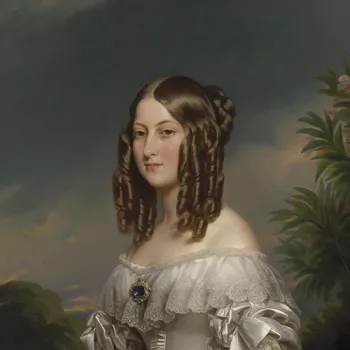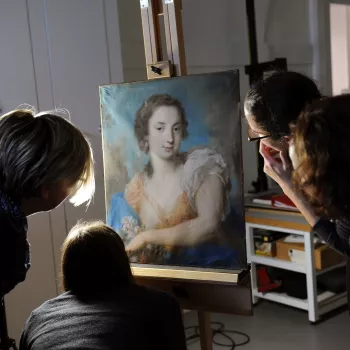A Georgian artwork brought back to life

Reading time: 3 minutes
After over forty hours of conservation treatment, an artwork from the Georgian era has been returned to its intended look by the artist. Hidden details have been revealed after Royal Collection Trust conservators converted the discoloured white pigment.
Pigments are created using a wide range of materials including minerals, plants, and insects. Over time environmental factors can cause these pigments to deteriorate. Pigments may fade, change colour, or be permanently lost. In this case study we explore how conservation treatment allowed us to return the artwork to its original appearance and reveal hidden details lost over time.
The artwork
In the hand-coloured etching, we can see a crowd of people in front of St Paul’s Church in Covent Garden, London, for the 1796 Westminster election. These gatherings or ‘hustings’ were common during this period. Candidates would give speeches to the crowds and a show of hands was taken to indicate the opinion of the voters.
Many of the figures are wearing blue wool coats over buff-coloured waistcoats and breeches. This was a popular ensemble that was adopted by the British political party known as the Whigs. Many of them are also wearing white cravats, which were a fashionable type of neckwear.
Charles James Fox was the leader of the Whig political party during this election and is shown on the platform in the centre. In the foreground a woman wearing a peach-coloured shawl and green quilted petticoat hands out copies of Fox’s speeches. Thanks to the work of conservators, the papers appear cleaner and the text is sharper on the pamphlets she is holding.
Lost details
During the conservation assessment it was clear that something didn’t look right. The cravats, which should have appeared white, displayed black and grey discolouration in some areas. The same issue was observed on the faces of many figures, including the lady in the centre wearing the green petticoat.
The papers held by the people in the crowd also showed similar discolouration, and the wooden signposts at the back were difficult to read. This discolouration is caused by the darkening of a lead white pigment, which had been used to paint the white areas and create highlights, and was mixed with other colours, such as red, to depict skin tones.
A toxic pigment
Lead white was a popular choice for artists until the 19th century. It had excellent covering power, being both dense and opaque. However, its toxicity, owing to its lead content, made it extremely hazardous to use. Today safer non-toxic white pigments, such as zinc white and titanium white are used instead.
The lead white pigment can start to change colour, darkening to black or brown when exposed to a common pollutant in the air called hydrogen sulphide.
Treatment
With careful treatment, the darkened lead white areas were converted to their original white appearance. The process involves applying tiny amounts of hydrogen peroxide mixed with a chemical called diethyl ether. The discoloured lead sulphide is converted to lead sulphate, which is a new chemical compound that appears white.
Using a fine brush, the solution is applied to the darkened areas with gentle strokes. The process is repeated until the lead white discolouration is converted, and the darkening is no longer visible. The success of the treatment may vary, and it can take time to achieve the desired result.
The conservation process has been used for many years, and success depends on careful testing and risk assessment of the materials used. It is important to ensure that the visual improvement is consistent across the whole artwork and that the treatment is not overdone.
The conservation treatment allows us to see the artwork as it had originally been created by the artist. The discoloured faces that appeared muddied have now regained their original skin tones and the cravats worn by the figures appear white again. The wooden signposts that were previously illegible can now be read. The conservation treatment has brought the artwork back to life, restoring its vibrancy and allowing it to be fully appreciated once again.
A Georgian artwork brought back to life ©














